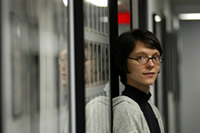|
|
Vol.
32 No. 6
November-December 2010
From the Editor
Remember why we meet! This is one lesson of the Karlsruhe meeting, the first international gathering of chemists. Held 150 years ago, the “first professional congress of a scientific discipline” set the stage for the entire scientific community. Be it a conference, a symposium, a workshop, a committee meeting, or a seminar, for the event to succeed it is important that the goals be clearly set.
 Mönnich’s article describes how, in 1860 in Karlsruhe, the goals of the meeting were evident, as were the organizers plans to achieve them. Although the congress ultimately did not resolve confusions regarding the concepts “atom,” “molecule,” and “equivalence,” the debates which took place, generated the necessary momentum for the community of chemists to pursue a common nomenclature. Mönnich’s article describes how, in 1860 in Karlsruhe, the goals of the meeting were evident, as were the organizers plans to achieve them. Although the congress ultimately did not resolve confusions regarding the concepts “atom,” “molecule,” and “equivalence,” the debates which took place, generated the necessary momentum for the community of chemists to pursue a common nomenclature.
In IUPAC, we certainly know the value of meetings, and there are several programs and activities that recognize this. For instance, each year IUPAC sponsors about 30 independently organized events that cover a wide range of topics in chemistry. The program guidelines stipulate that “sponsorship by IUPAC attests to the quality of the scientific program and indicates the host country’s assurance that scientists from all countries may participate.” The other program that acknowledges the value of the meeting is the project-driven system. In place now for about 10 years, it is the core modus operandi of what IUPAC achieves, as it allows task groups—mostly international teams—to focus on specific issues, most of which relate to improving communication among the chemists or the world or expanding the role of chemistry. In most cases, the majority of project budgets is devoted to travel and per diem expenses. A final example of IUPAC’s dedication to the meeting, is the General Assembly held every two years, which is coordinated in parallel with the biennial IUPAC Congress. This unique gathering allows all IUPAC committees to meet at a place and time where individual scientists can also mingle with attendees at the larger gathering of the Congress. The IUPAC Council also meets on that occasion.
In addition to all these traditional modes of meeting, the scientific community now has more tools than ever to communicate and reach consensus. Like never before, Web-based technologies empower individuals to reach out in new ways. How these tools will be best used to promote and advance scientific communication is yet to be fully appreciated, but it is certain that just as the Karlsruhe meeting was a historical event in 1860, we are today part of a new chapter in history. Perhaps a Wiki-like community that holds virtual meetings will develop that will eclipse many of our current gatherings as we know them, pushing social scientific networking into uncharted territory.
Fabienne Meyers
[email protected]
Page
last modified 17 November 2010.
Copyright © 2003-2010 International Union of Pure and Applied Chemistry.
Questions regarding the website, please contact [email protected] |